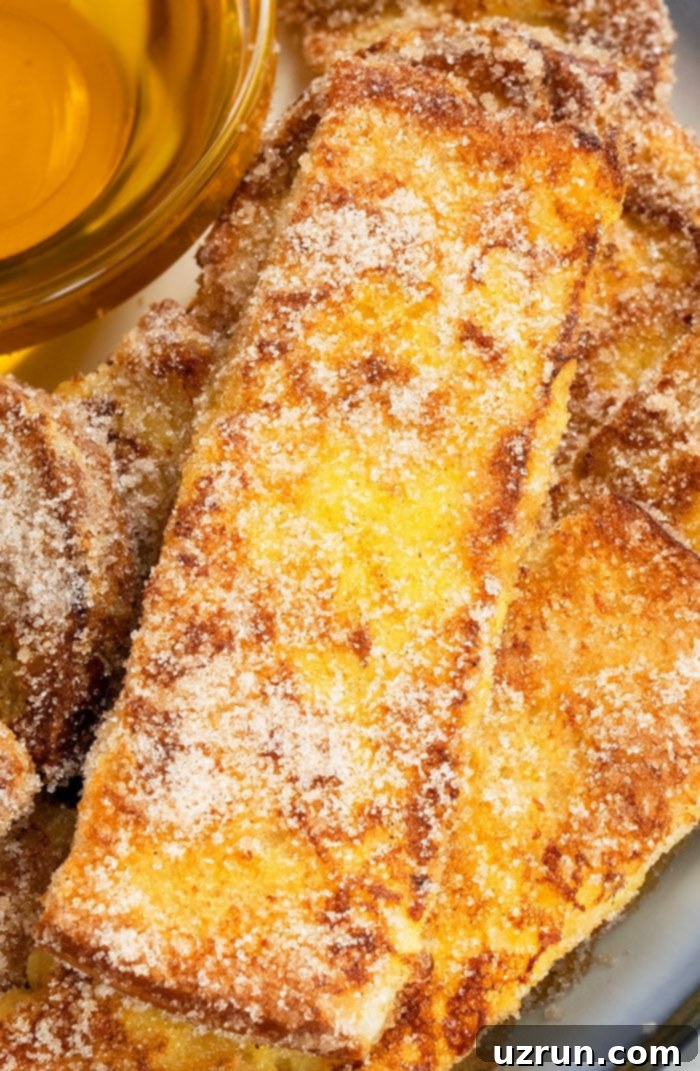Easy Homemade Cinnamon French Toast Sticks: The Ultimate Recipe for Crispy & Fluffy Breakfast
Imagine waking up to the aroma of warm cinnamon and sweet vanilla filling your kitchen. With this incredible recipe for homemade cinnamon French toast sticks, that dream breakfast is not only possible but incredibly easy to achieve. Forget the store-bought versions; these bite-sized delights are soft and custardy on the inside, yet wonderfully firm and crispy on the outside, coated in a delightful cinnamon sugar blend. They’re quick enough for a weekday treat and impressive enough for a leisurely weekend brunch or even special holiday mornings. Get ready to transform simple ingredients into a breakfast masterpiece!
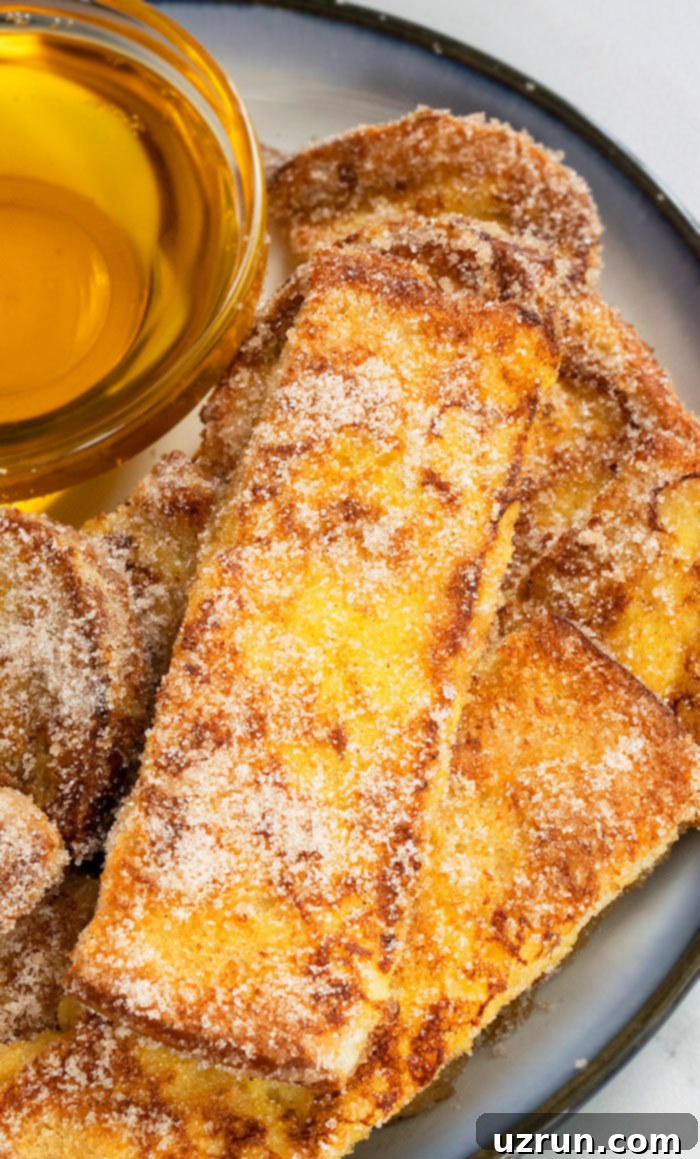
Breakfast often gets overlooked in our busy lives, but it can truly be the most delicious and comforting meal of the day. Our recipe for French toast sticks takes this beloved classic and makes it even more fun and accessible. No longer will you need to rely on frozen versions from the grocery store – making them from scratch is surprisingly simple and yields a product that tastes infinitely better. These French toast sticks are an absolute hit, especially perfect for festive occasions like Christmas mornings, perhaps even alongside a batch of Eggnog French Toast for an extra festive touch. The secret to truly outstanding French toast, in my opinion, lies in achieving that perfect textural balance: a delightfully crispy exterior giving way to a soft, custardy interior. They also need to be firm enough to pick up and dip without falling apart, and I’m thrilled to share all my secret tips and tricks to ensure your French toast sticks hit all these marks!
This recipe isn’t just about taste; it’s about creating a memorable breakfast experience. The convenience of these sticks makes them a favorite for families, allowing for easy dipping in maple syrup, fresh fruit, or any topping your heart desires. They’re a fantastic way to elevate your morning routine without spending hours in the kitchen, proving that gourmet-level breakfast can be both quick and effortless.
[feast_advanced_jump_to]
How to Make Perfect Cinnamon French Toast Sticks
Creating these delectable French toast sticks is a straightforward process, broken down into a few simple steps. Follow along to make your best batch yet!
- Prepare the Custard Mixture: In a shallow bowl, whisk together the eggs, milk, and vanilla extract until well combined and slightly frothy. This is your flavorful custard, essential for moistening the bread.
- Whip Up the Cinnamon Sugar: On a separate plate or in a shallow dish, combine the granulated sugar and ground cinnamon. Mix thoroughly. This aromatic coating is what gives these sticks their signature cinnamon French toast flavor.
- Dip the Bread: Take your bread slices (which you’ve already cut into sticks – see tips below!) and quickly dip them into the egg mixture. Ensure both sides are coated, but avoid over-soaking, as this can lead to soggy French toast. A quick dunk and flip is usually all it takes.
- Pan Fry to Golden Perfection: Place the coated bread sticks onto a preheated, buttered pan or griddle. Cook each side over medium heat until they turn a beautiful golden brown and are crispy. Remember to work in batches to avoid overcrowding the pan.
- Coat in Cinnamon Sugar: Immediately after removing the warm French toast sticks from the pan, toss them gently in the cinnamon sugar mixture. The warmth of the sticks will help the sugar adhere perfectly, creating that irresistible sweet and spiced crust.
- Serve and Savor! Serve your homemade cinnamon French toast sticks immediately while they are still warm, ensuring that delightful contrast of a crispy exterior and a soft, fluffy interior.
Key Ingredients & Why They Matter for Amazing French Toast Sticks
While the recipe uses simple ingredients, understanding their role is key to achieving the best results:
- Eggs: These are the base of your custard, providing richness and helping the bread achieve that golden-brown color and custardy texture when cooked.
- Milk: Thins the egg mixture, allowing it to penetrate the bread more evenly. You can use any type of milk (whole, 2%, skim, or even non-dairy alternatives) depending on your preference for richness.
- Vanilla Extract: A non-negotiable for French toast! It adds a warm, sweet, and aromatic depth that truly enhances the flavor profile.
- Granulated Sugar & Cinnamon Powder: This simple yet powerful combination creates the iconic sweet and spiced coating that defines cinnamon French toast. The sugar caramelizes slightly on the outside, adding to the crispness.
- Unsalted Butter: Used for pan-frying, butter not only prevents sticking but also imparts a rich, nutty flavor that oil simply can’t replicate. Using unsalted butter allows you to control the overall saltiness of your dish.
- Bread: The unsung hero! The type and freshness of your bread dramatically impact the final texture. We’ll delve deeper into this below.
Choosing the Best Bread for Your French Toast Sticks
The foundation of great French toast is the bread. It’s often where people go wrong, leading to either soggy or dry results. Here’s what you need to know:
- Opt for Stale or Day-Old Bread: This is perhaps the most crucial tip! Fresh bread, especially soft sandwich bread, acts like a sponge, soaking up too much of the egg custard mixture. The result? A soggy, limp French toast stick that lacks the desired crispy exterior. Stale or slightly dried-out bread, on the other hand, absorbs the perfect amount of custard, leading to that ideal balance of soft inside and firm outside. It’s also an excellent way to repurpose bread that’s a day or two past its prime, reducing food waste!
- Prioritize Thick Bread: While you can technically use regular sandwich bread, thicker varieties generally yield superior results. Breads like challah, brioche, or Texas toast are ideal. Their denser crumb and thicker slices allow them to hold up better to the egg mixture, creating a more substantial and satisfying French toast stick. Thinner bread tends to absorb liquid too quickly and can become mushy.
- No Stale Bread? No Problem!: Don’t have any stale bread on hand? No worries! You can quickly “stale” fresh bread. Simply arrange your bread slices on a baking sheet and bake them in a preheated 350°F (175°C) oven for about 5-6 minutes per side. This dries them out just enough to prevent sogginess without toasting them completely.
- Cutting Your Bread: For sticks, simply take your chosen bread slices and cut them lengthwise into 2 or 3 equal strips. This shape makes them perfect for dipping and easy for little hands to hold.
How to Freeze and Reheat French Toast Sticks (with a caveat!)
French toast sticks can be made ahead and frozen for a quick breakfast on busy mornings, but there’s a specific way to do it and a texture note to consider. If you plan to freeze them, prepare them according to the recipe instructions below, but do not coat them in cinnamon sugar after cooking. The sugar can become sticky and less pleasant upon thawing and reheating.
Once cooked, place the French toast sticks on a cookie tray lined with parchment paper in a single layer. Allow them to cool down completely to room temperature. This step is crucial to prevent ice crystals from forming. Once cooled, freeze them on the tray for 2-3 hours until solid. This “flash freezing” prevents them from sticking together when stored. Afterward, transfer the frozen sticks to an airtight sealed container or freezer-safe bag. They can be stored in the freezer for up to 1 month.
To reheat, you have a couple of options: you can warm them in the microwave for a minute or two, or for a crispier result, heat them in a preheated 350°F (175°C) oven for 8-10 minutes, flipping halfway through. If you prefer to add the cinnamon sugar, you can do so after reheating, perhaps brushing them lightly with melted butter first to help the sugar stick.
However, with all that being said, I must admit a personal preference: I DO NOT typically like to freeze and reheat French toast sticks because their texture is simply not the same as when they are freshly prepared. The beautiful crispness they have right off the pan diminishes considerably, even when reheated in the oven. While they are still tasty, they tend to be softer and lack that signature bite. If fresh is best for you, I recommend making them just before serving!
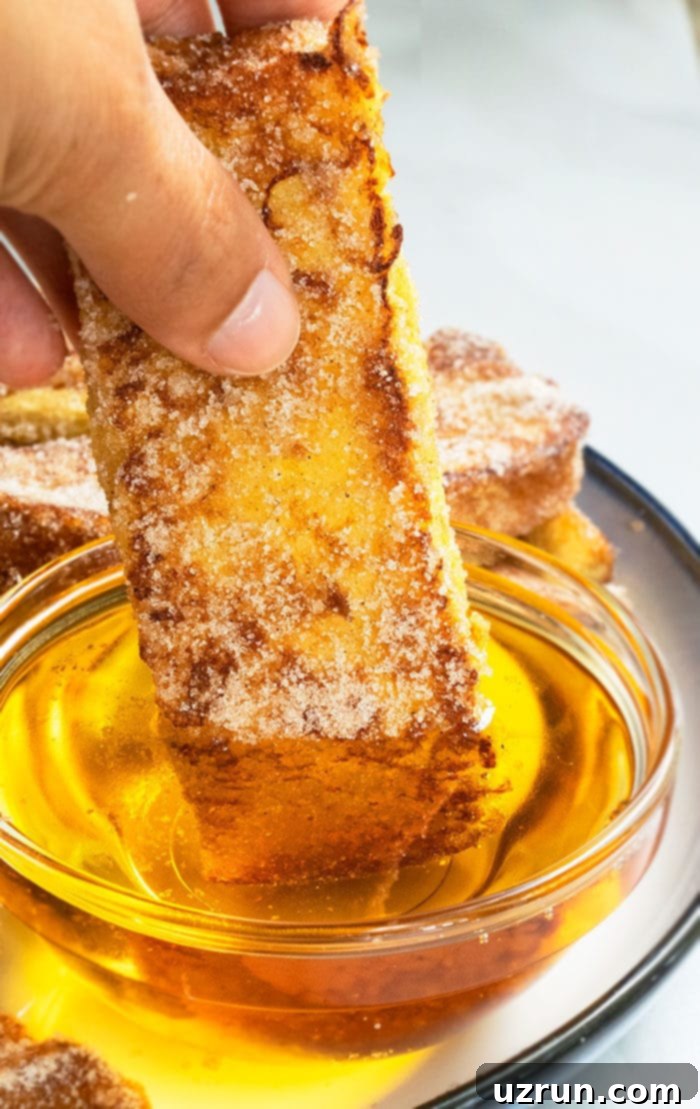
Baked French Toast Sticks vs. Pan-Fried French Toast Sticks: Which is Best?
There are two primary methods for cooking French toast sticks: baking and pan-frying. While both can yield delicious results, they offer distinct textures and flavors. Between the two, I unequivocally prefer the classic pan-fried version, which is what this recipe focuses on. Here’s a comparison:
Pan-Fried French Toast Sticks (Our Recommended Method):
This method involves cooking the bread sticks in butter on a griddle or nonstick pan. The advantages are clear: you get an incredibly rich flavor from the butter, a beautifully crisp and golden-brown exterior, and a perfectly custardy interior. The direct heat and fat create a superior textural contrast that is hard to beat. Each stick develops a delightful crust that locks in moisture and adds a satisfying crunch. This is the method that truly delivers that “best French toast” experience: crispy on the outside, soft on the inside, and firm enough to handle.
Baked French Toast Sticks:
For those looking for a slightly less hands-on approach or cooking for a crowd, baking is an option. To prepare baked French toast sticks, you would dip the bread in the egg mixture, shake off any excess liquid, and then arrange the slices on a baking tray. Bake them in a 350°F (175°C) oven for 10-12 minutes on one side, then flip them and bake for another 10-12 minutes, or until they are golden brown. After removing them from the oven, you typically brush melted butter over each bread stick and then coat them in cinnamon sugar.
While baked French toast sticks are convenient and require less active cooking time, they generally result in a softer, more uniformly textured product. They tend to be less crispy on the exterior compared to their pan-fried counterparts, and the flavor might be less rich due to the lack of direct contact with butter during cooking. If texture is paramount, pan-frying is the way to go.
French Toast Toppings: Elevate Your Breakfast Experience
Once you’ve mastered the art of making perfect cinnamon French toast sticks, the fun doesn’t stop there! The possibilities for toppings are endless, allowing you to customize each serving to your liking. While classic maple syrup or a simple dusting of powdered sugar are always delicious choices, why not get creative with some of these other fantastic ideas?
- Maple Syrup: The timeless classic. Opt for pure maple syrup for the best flavor.
- Honey: A sweet, natural alternative to maple syrup, offering a distinct floral note.
- Homemade Whipped Cream: Light, airy, and utterly decadent. Try flavoring it with vanilla, cinnamon, or even a hint of espresso.
- Ice Cream: For a truly indulgent treat, especially with warm French toast sticks. Vanilla or a complementary flavor like coffee or salted caramel works wonders.
- Melted Chocolate: Drizzle with milk, dark, or white chocolate for a rich, sweet topping.
- Warm Nutella or Nutella Syrup: A hazelnut-chocolate dream that pairs perfectly with cinnamon.
- Warm Peanut Butter: Creamy and savory-sweet, a great source of protein.
- Warm Biscoff or Cookie Butter: A unique, spiced cookie flavor that complements cinnamon beautifully.
- Caramel Sauce: Rich, buttery, and incredibly luxurious.
- Dulce de Leche: A thick, sweet milk caramel that’s truly divine.
- Chocolate Ganache: A glossy, smooth, and intensely chocolatey topping.
- Chocolate Syrup: A simpler, yet still satisfying chocolate option.
- Fresh Fruits: Add a burst of freshness and natural sweetness. Think sliced strawberries, raspberries, blackberries, blueberries, peaches, or bananas.
- Chopped Nuts: Almonds, pecans, walnuts, or pistachios add a lovely crunch and earthy flavor.
- Dried Fruits: Raisins, cranberries, or chopped apricots for concentrated sweetness and chewiness.
- Chopped Up Candy Bars: A fun, over-the-top option for a dessert-like breakfast.
- Jams and Preserves: Classic fruit flavors like Easy Homemade Strawberry Jam, raspberry, or apricot add a delightful fruity tang.
- Chocolate Chips: Sprinkle them on top while the French toast sticks are still warm so they melt slightly.
- Flavored Yogurt: A lighter option that adds a creamy texture and a touch of tang.
- Pie Fillings: Transform your French toast sticks into a dessert with fruit pie fillings like Raspberry Pie Filling, Cherry Pie Filling, Blueberry Pie Filling, or Peach Pie Filling.
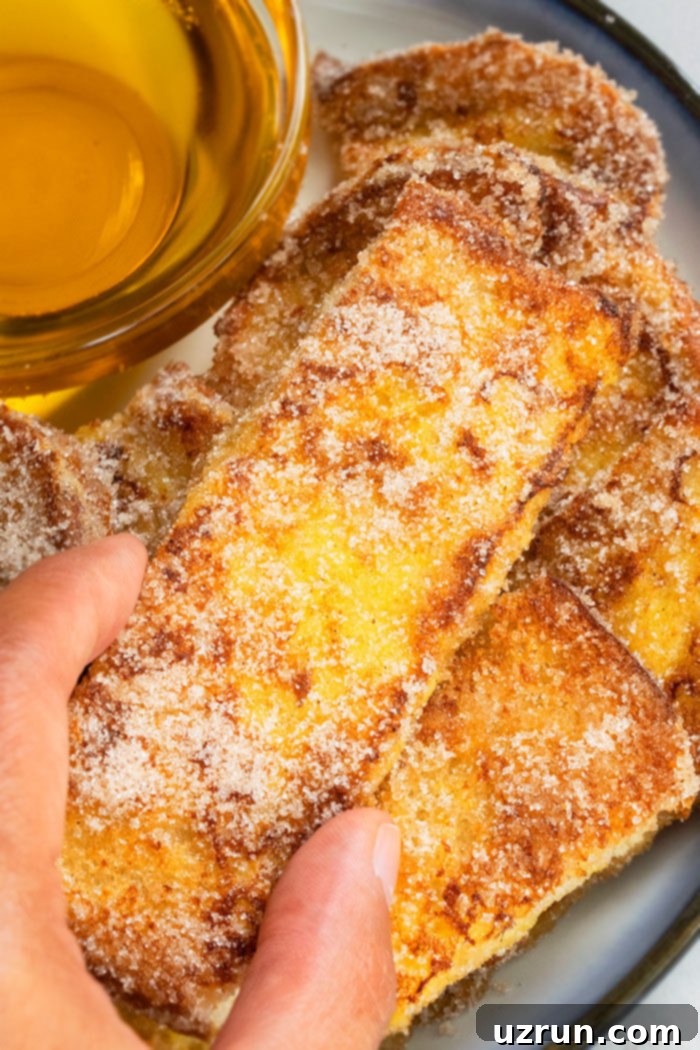
Pro Tips and Techniques for Flawless French Toast Sticks Every Time
Achieving perfectly crispy yet soft French toast sticks isn’t just about following the recipe; it’s about understanding the nuances of the cooking process. Here are my essential tips and techniques to help you master this delicious breakfast:
- The Stale Bread Advantage: As mentioned, using stale or day-old bread is key. Fresh bread is too soft and absorbent, leading to a soggy, undesirable texture. Stale bread allows for just the right amount of egg custard to be absorbed, resulting in a firm but moist interior and a beautifully crisp exterior. This also makes your French toast easier to handle and less likely to fall apart on the pan.
- The Power of Thick Bread: While you can use standard sandwich bread, thick-cut breads like challah, brioche, or Texas toast are far superior. Their robust structure can handle the custard without becoming mushy, and the extra thickness means a more satisfying, custardy bite in the center once cooked. If you’re using thinner bread, be extra quick with your dipping!
- Instant Stale Bread Hack: If you only have fresh bread, simply place your slices on a baking sheet and bake at 350°F (175°C) for 5-6 minutes per side. This will dry them out enough to mimic stale bread, preventing the dreaded soggy French toast.
- Butter for Flavor, Not Just Grease: While oil can be used for frying, butter truly elevates the flavor of your French toast. It adds a rich, nutty, and slightly caramelized taste that complements the cinnamon beautifully. Always use unsalted butter to control the overall sodium content of your dish.
- Don’t Crowd the Pan (Work in Batches!): This is a common mistake. If your pan is too full, the temperature will drop, and the French toast sticks will steam rather than fry. This results in soft, pale sticks instead of golden, crispy ones. Work in small batches, giving each stick enough space to cook evenly and brown beautifully. If you have a large griddle, you might be able to cook more at once, but for standard nonstick pans, a few sticks at a time is best.
- Perfect Soaking Time is Crucial: The ideal soaking time depends on the dryness and thickness of your bread. For very dry, thick bread, a slightly longer soak might be necessary to ensure the custard penetrates the center. However, for most breads, a quick dip and flip is sufficient. I typically drop a bread stick into the egg mixture, quickly flip it to coat the other side, and then immediately transfer it to the hot pan. Over-soaking is the fast track to soggy French toast. If it’s not soaked long enough, the center will be dry and bready. My advice? Test with one or two sticks first to gauge the perfect soaking time for your specific bread, then proceed with the rest.
- Mind the Pan Temperature: Avoid overheating your pan! If the heat is too high, the outside of your French toast will burn quickly, while the inside remains raw or soggy. Medium heat is usually perfect – it allows the exterior to brown gradually while the interior cooks through and becomes custardy. If your pan starts to smoke, it’s too hot.
- Unsalted Butter for Better Control: Always opt for unsalted butter when frying. This allows you to season the French toast to your liking without worrying about it becoming overly salty, especially since you’ll be adding sweet toppings.
- Coat Immediately in Cinnamon Sugar: Timing is everything for the sugar coating. As soon as the French toast sticks come off the pan, they need to be warm for the cinnamon sugar to adhere properly. If they cool down too much, the sugar won’t stick, and you’ll miss out on that delicious, sweet crust. Have your cinnamon sugar mixture ready and waiting!
- To Crust or Not to Crust?: This is entirely a personal preference. Many people prefer to remove the crusts from their bread before dipping for a more uniform and softer texture. Personally, I don’t mind the crusts; they add a little extra chewiness and fiber. Do whatever you prefer!
- Make-Ahead Prep: While I don’t recommend cooking the French toast sticks entirely in advance and storing them (due to texture loss upon reheating), you can certainly do a lot of prep work ahead of time. The egg custard mixture can be whisked together and stored in an airtight container in the fridge for up to a day. The cinnamon sugar mixture can also be prepared and kept ready. You can even slice your bread into sticks the day before. This way, on the morning you plan to serve them, all you have to do is dip and fry!
More Delicious Cinnamon Desserts You’ll Love
If you’re a fan of the warm, comforting spice of cinnamon, you’ll definitely want to try these other delightful recipes:
- Cinnamon Roll Cake (With Cake Mix)
- Easy Homemade Cinnamon Rolls (1 Hour)
- Cinnamon Cookies (Soft and Chewy)
- Fluffy Cinnamon Pancakes
- Cinnamon Muffins
Recipe Card: Easy Cinnamon French Toast Sticks
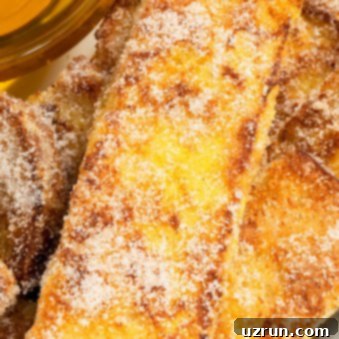
Cinnamon French Toast Sticks
Abeer Rizvi
Pin Recipe
Want to Save This Recipe?
Enter your email & I’ll send it to your inbox. Plus, get great new recipes from me every week!
By submitting this form, you consent to receive emails from CakeWhiz
Ingredients
- 2 Large Eggs
- ¼ cup Milk 2% or whole milk recommended
- 1 teaspoon Vanilla extract
- ⅓ cup Granulated sugar
- 1 teaspoon Cinnamon powder
- Unsalted Butter As needed for pan frying (approximately 1-2 tbsp per batch)
- 4 slices Thick White Bread Stale or day-old, such as Texas toast or challah, cut into 3 equal sticks each
Instructions
-
In a shallow mixing bowl, whisk together the eggs, milk, and vanilla extract until smooth and well combined. Set this egg custard mixture aside.
-
On a separate plate or shallow dish, mix together the granulated sugar and cinnamon powder thoroughly. This is your cinnamon sugar coating. Set aside.
-
Melt 1-2 tablespoons of unsalted butter in a large nonstick pan or griddle over medium heat. Ensure the butter coats the pan evenly.
-
Take your pre-cut bread sticks and quickly dip them into the egg mixture. Ensure both sides are coated, but promptly remove them from the bowl. Avoid letting them soak for too long, as this will lead to soggy French toast.
-
Gently shake off any excess liquid and carefully place the coated bread sticks onto the hot, buttered pan. Pan-fry each side until they are beautifully golden brown and crispy, about 2-3 minutes per side. Remember to work in batches to prevent overcrowding the pan, adding more butter as needed between batches.
-
Immediately after removing the hot French toast sticks from the pan, roll them quickly in the prepared cinnamon sugar mixture until they are fully and evenly coated. The warmth from the sticks will help the sugar adhere perfectly.
-
Serve your delicious homemade cinnamon French toast sticks immediately with your favorite toppings. Enjoy the perfect balance of crispy edges and a soft, custardy interior!
Notes
- For best results, please read all the detailed tips and techniques provided above in the article to ensure your French toast sticks are perfect every time.
- These French toast sticks taste best when served immediately. While leftovers can be stored in an airtight container in the refrigerator for up to 2 days, please note they will lose their crispness. Reheat gently in a toaster oven or oven for best texture.
Nutrition Information
An automated tool is used to calculate the nutritional information. As such, I cannot guarantee the accuracy of the nutritional information provided for any recipe on this site.
With these comprehensive tips and this easy-to-follow recipe, you’re now equipped to create the most delicious cinnamon French toast sticks that will impress everyone at your breakfast table. Whether it’s a quick morning treat or a special brunch centerpiece, these homemade delights are sure to become a cherished favorite. Enjoy the process, savor the flavors, and happy cooking!
